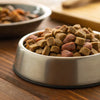Is Feeding Your Dog Raw Food Good? Exploring the Pros and Cons of Raw Diets
- Houndsy
Table of Contents
- Introduction
- What Constitutes a Raw Dog Food Diet?
- Potential Benefits of Feeding Raw Food
- Risks and Concerns of Raw Dog Food Diets
- Finding a Balanced Approach: Should We Transition to Raw?
- Conclusion
Introduction
Imagine the excitement of every mealtime, not just for you but for your furry friend, who eagerly awaits their dish filled with fresh, nourishing ingredients. Perhaps you've been tempted by the rising popularity of raw diets for dogs—a trend that beckons many dog owners with promises of shinier coats, better health, and increased energy. However, with all the buzz, one critical question arises: is feeding your dog raw food good?
The conversation around dog nutrition is charged with opinions, studies, and heartfelt testimonials from pet owners. As the pet care landscape evolves, pet parents are increasingly exploring alternative feeding methods, with raw dog food diets frequently in the spotlight. The raw food movement has even evolved from recommendations by forward-thinking veterinarians; it claims to harness the benefits that mimic the ancestral diets of dogs. This enables them to thrive on natural, unprocessed ingredients.
In this blog post, we will delve into the intricacies of raw dog food diets—examining the benefits, potential risks, nutritional considerations, and significant factors you should weigh before making any dietary changes for your canine companion. By the end, we hope to inspire you to reflect on your own pet feeding practices and consider what dietary approach aligns best with your furry friend's needs.
From the arguments made by raw food advocates touting health benefits, to the concerns raised by veterinary experts regarding safety and nutritional balance, we will provide a well-rounded perspective that informs your feeding choices. Let’s start by breaking down what a raw food diet for dogs entails.
What Constitutes a Raw Dog Food Diet?
At its core, a raw dog food diet (often referred to as a raw meat-based diet, or RMBD) typically includes:
- Muscle Meat: Unprocessed cuts, often still on the bone.
- Organ Meats: Nutrient-rich parts like liver and kidneys.
- Raw Bones: Either whole or ground; bones can provide essential minerals.
- Raw Eggs: A versatile source of protein and healthy fats.
- Vegetables: Staples like broccoli and carrots, which can give additional nutrients and fiber.
- Fruits: Apples, berries, and other dog-friendly fruits that contribute vitamins and antioxidants.
- Dairy Products: Ingredients like yogurt that can aid digestion.
Different formulations exist, including homemade versions and commercial brands that ensure the diet remains balanced. The premise of raw feeding is to rely on whole foods that dogs would naturally consume in the wild, reducing the reliance on processed and potentially harmful ingredients found in some commercial pet foods.
History and Evolution
The raw dog food movement gained traction in the 1990s largely due to Australian veterinarian Ian Billinghurst, who introduced the BARF diet—short for Bones and Raw Food or Biologically Appropriate Raw Food. Billinghurst argued that the evolution of dogs shows their optimal health is supported by a diet rich in raw, meaty bones and limited grains. This theory sparked a natural food revolution that continues to influence how we view dog nutrition today.
Despite its historical context and growing popularity, it’s important to recognize that trends in pet food evolve rapidly. What might be beneficial for one dog could be detrimental to another, leading us into the next critical discussion: the benefits of feeding a raw dog food diet.
Potential Benefits of Feeding Raw Food
Many proponents of raw diets for dogs celebrate the potential health benefits observed in their pets. Some of the commonly cited advantages include:
1. Increased Energy and Vitality
Pet owners often report that their dogs exhibit higher energy levels after switching to a raw diet. A diet rich in high-quality proteins provides the necessary building blocks for increased muscle development and energy production, resulting in an overall more active pet.
2. Improved Coat Condition
A raw diet can contribute to a shinier, healthier coat. The higher fat content present in many raw diets improves skin hydration and fur quality, leading to a glossy appearance.
3. Cleaner Teeth and Fresh Breath
The mechanical action of chewing on raw bones can aid in reducing plaque and tartar buildup, thus promoting better dental hygiene. Many pet owners have noted fresher breath and cleaner teeth with their dogs on a raw diet.
4. Smaller, Firmer Stools
As raw food is easier for dogs to digest, many owners find their pets produce smaller, firmer droppings compared to those fed commercially-produced kibble. This is attributed to the higher protein content and lower carbohydrate filler, allowing for better nutrient absorption.
5. Potential Allergy Management
Some dogs with food sensitivities or allergies have seen improvements on a raw food diet. With fewer common allergens found in natural ingredients, pet owners often report a decrease in allergic reactions such as itchy skin or gastrointestinal issues.
6. Enhanced Immune Function
Advocates argue that feeding dogs a raw diet supports a well-functioning immune system as it contains natural enzymes and nutrients that bolster overall health. Healthy digestion is often linked to a robust immune response.
While these benefits sound appealing, we cannot ignore the potential downsides associated with raw dog food diets, which leads us to a critical analysis of the risks.
Risks and Concerns of Raw Dog Food Diets
As alluring as the benefits may seem, there are numerous risks and concerns regarding the safety and efficacy of raw dog food diets.
1. Risks of Bacterial Contamination
A paramount concern is the risk of pathogens like Salmonella and Listeria that can be found in raw meat. These bacteria can not only be harmful to dogs but can also pose serious health risks to humans handling the food. A study revealed that nearly a quarter of commercially sold raw dog food contained harmful bacteria.
2. Nutritional Deficiencies
Raw diets can sometimes fall short of providing a complete and balanced nutritional profile. Dogs have specific dietary needs that if not met can lead to deficiencies over time. A lack of essential vitamins and minerals can result in serious health issues.
3. Choking Hazards and Internal Injuries
Feeding raw bones can lead to choking hazards, broken teeth, or internal punctures if bones splinter. Pet owners should exercise caution and consult a veterinarian about appropriate bone selections.
4. Uncertainty of Ingredients
Commercial raw food diets can vary significantly in quality. Some may not undergo stringent quality control measures, leaving room for inconsistencies in nutrient levels. Without careful labeling and verification, pet owners may unknowingly compromise their pet's health.
5. Increased Expense and Preparation Time
Feeding a raw diet often requires significant time, effort, and financial investment. Pet owners must be committed to sourcing high-quality ingredients, preparing meals, and ensuring proper handling to mitigate contamination risks.
Examining these risks is essential as we navigate our understanding of raw feeding; however, many pet owners still advocate for incorporating raw elements into their dogs' diets. This grey area leads us to consider how a balanced approach may look in practice.
Finding a Balanced Approach: Should We Transition to Raw?
Transitioning to a raw food diet can be daunting, but with careful planning and guidance, pet owners can find a balance that works for both them and their pets. Here are some steps to consider if you are thinking about switching your dog to a raw diet:
1. Consult a Veterinarian or Animal Nutritionist
Before making any drastic dietary changes, consulting a veterinary professional is crucial. They can provide tailored insights based on your dog’s specific health needs and dietary requirements.
2. Start Slowly
If you decide to make the switch, introduce raw food gradually. Start by combining raw ingredients with your dog's regular kibble to help their digestive system adjust.
3. Research Quality Sources
Should you choose commercial raw diets, thoroughly research brands that emphasize high-quality, sourced ingredients. Look for those that provide evidence of nutritional adequacy and quality assurance.
4. Consider Food Safety Practices
If preparing homemade raw meals, maintain strict hygiene standards. Proper handling, cleaning of surfaces, and storage are paramount to mitigate any contamination risks.
5. Observe and Adapt
Pay close attention to your dog's health and behavior during dietary changes. Monitor their digestion, energy levels, coat condition, and overall happiness—adjusting as necessary based on individualized responses.
This balanced approach reassures pet owners that while raw diets provide potential benefits, informed choices are crucial to ensure the health and happiness of their four-legged friends.
Conclusion
In summary, the question of is feeding your dog raw food good? does not have a straightforward answer. While there are appealing advantages associated with raw diets, such as improved vitality and better digestion, the accompanying risks—bacterial contamination, nutritional deficiencies, and physical hazards—cannot be overlooked.
As conscientious pet parents, our ultimate goal should be clear: nourishing our beloved companions in the healthiest way possible. Whether that includes raw food, commercial kibble, home-cooked meals, or a careful combination of approaches, it is crucial to evaluate all possibilities and make informed decisions.
We invite you to reflect on your current feeding practices and consider how our flagship product, the Houndsy Kibble Dispenser, can help elevate your dog’s feeding experience. The Houndsy Kibble Dispenser combines innovative design, ergonomic convenience, and aesthetic appeal to create a seamless feeding ritual that is beautiful and functional.
FAQ
1. Can dogs thrive on a raw food diet?
While some dogs show benefits from raw food diets, proper planning and nutritional balance are paramount to prevent deficiencies and health complications.
2. What raw foods should be included for a balanced diet?
A balanced raw diet should include a variety of muscle meats, organ meats, whole or ground bones, vegetables, fruits, and occasionally dairy products, to meet the nutritional needs of dogs.
3. What are some signs that a raw diet isn't working for my dog?
Signs may include vomiting, diarrhea, weight loss, lethargy, or a dull coat. If any of these symptoms occur, consult your veterinarian immediately.
4. Is it safe to feed my dog raw meat?
Feeding raw meat carries some health risks, including bacterial infection and potential nutritional imbalance. Always consult your vet before transitioning your dog to a raw diet.
5. How can I minimize the risks associated with feeding raw food?
To minimize risks, ensure safe handling of raw meats, maintain hygiene, monitor ingredient quality, and work with a veterinary nutritionist to formulate a balanced raw diet.
As we continue to learn and adapt our feeding methods, let’s remember our primary focus: to deliver the best care for our furry friends.












